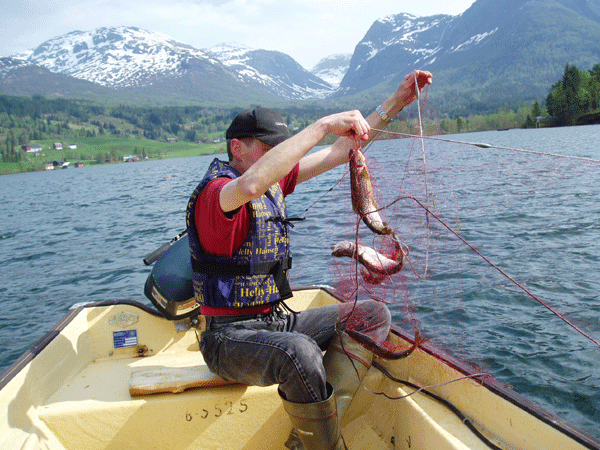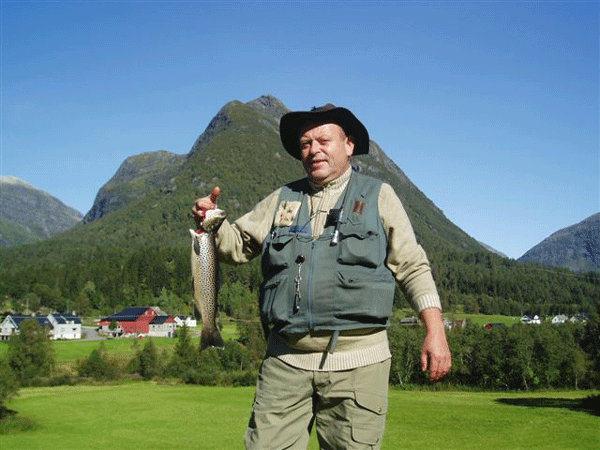Rake fish is a Norwegian specialty made of trout
Shopping List for many adults
|
This will be used for salting:
10 live trout between 550 g and 750 g each It is important that all trout are equal and total fresh 60 grams of salt per kilogram of slaughtered fish 6 % salt/kg fish ½ tsp. sugar per layer fish in the "barrel" This will be used for new brine: 1 liter of water 50 g salt Boiled and cooled to 5 ° C Rakefisk is a Norwegian specialty which is made of small trout. It is most trout, røye, char, whitefish, grayling and perch. In Denmark one could benefit from using rainbow trout. If you buy the fish, they must be a live on the purchase. The fish must not have been in contact with the soil. The word "barrel" refers to an approved food plastic container with a lid |
I am an angler in Scandinavia
Recipe No. 95
|
|
The method of salting without responsibility: I must immediately warn against making rake fish yourself if no hygiene and temperature can be respected to the letter. Trout should never come into contact with soil bacteria. This can happen if they have been on the ground, or been in contact with vegetables. All "tackle" must be clean and suitable for food. The temperature during the curing process - maturation - should not exceed 5-8°C. The barrel or plastic bucket is placed in a deep, dark cellar or in a refrigerator.
Now we can start. I usually cut the trout from the gat to the head and take the guts out. The gills cut out and all blood washed away. Obtain a 10 liter plastic bucket, it is used for tartar sauce, pickles and potato salad in commercial kitchens. Or a different size to suit the amount of fish that you will "rake". But remember that plastic bucket must be approved for food item. Here comes the Norwegian recipe and some Regu: Both enzymes and certain microorganisms found naturally in fish, they become active when the fish are slaughtered. The process is initiated in the fish, leading to altered taste and increase shelf life, food is easier to digest. One explanation is that the enzyme initiates a cleavage of the long protein molecules, while the naturally occurring lactic acid bacteria convert carbohydrates into acids. The process of raking of fish is a slow process where you have to play with the laws of nature. It is very important that everything must be scrupulously clean and accurate, so there is NOT blooms of undesirable bacteria (Clostridium botulinum, which in small doses is used in Botox). It also ensures that exclude air from the process, which could otherwise develop Botulinum toxin in the fish, if you is imprudent. Industrial fish checked for this before they reach the market. All contact with the soil and sand are absolutely prohibited. Food & Drug Administration expects all rakefisk also the commercially prepared is a risk product because of the danger of Listeria infection. Food Administration recommends that pregnant women and people with compromised immune systems (old and sick), do not eat fermented fish. There used fresh trout between 550 g 750 g or more of uniform size in the same barrel, which cleaned of gills and blood, rinsed, salted and layered with belly up in the barrel. Originally there used wooden barrels. But today is plastic by far the most common for most manufacturers, with the exception of the most exclusive. Using wooden barrels is a vulnerability in the process, and since plastic barrels gives more predictable results, preferred these. Then, cover the fish with brine before it is put to maturation. In some cases, rinse the fish in vinegar or placed in vinegar for half an hour before putting it in the barrel. In the belly of each fish added to 60 g of salt per kilogram of fish. Place a heavy plate over so the fish is pressed down the brine After a few days, check whether there is enough brine formed so that the fish is covered. If not, add more brine in the form of water and salt. The brine prepared from boiled water with 50 g of salt per liter of water. The ripening process can be controlled by temperature and time. When the fish put down it is mild in odor and taste, but maturation continues as long as the temperature is sufficiently high. The recipes are diverse and vary between communities. In some villages sprinkled little sugar in order to speed up fermentation. The fermentation can also help to get started by putting the barrel a little warmer up to 8°C for a few days, but it can quickly get out of control. Normal temperature during ripening is 4°C. There may also be significant differences from barrel to barrel with the same temperature depending on how carefully the fish is cleaned of excess blood. More blood gives a stronger taste. When the barrel is opened after the fish have matured, smells strong content. The contents have been through a fermentation process that has lasted for at least 8 weeks. The fish has in this time fermented and has been fermented trout. Some manufacturers believe that the best result is achieved by maturing at a low temperature for a long time. When the fish is fermented or matured, so it should be stored at 0-4 ° C (refrigerator temperature). If you want rakefisk with stronger flavor, so the fish can be kept one or two days at a somewhat higher temperature, up to about 8°C. When the fish is fermented or matured, it can be frozen. It stops the process. Vacuum packaging fish are particularly suitable for freezing. Fish in buckets or barrels that are not frozen, shall at all times be covered by the brine. If there is too little brine one can do something new, by boiling 50 grams of salt per liter of water. Let brine cool and pour over the fish. Fish placed in the brine should be frozen at very low temperatures to freeze. Maturation of fish can also be impeded by creating a new brine. This was prepared as above for replenishment, 50 g salt/liter of water. There can be some local variations, the most significant variation is the amount of blood left in the fish, as well as the possible use of sugar in the production. Added sugar will speed up the process. Variations may be where the barrel is placed. Put the barrel warmer so the process will go faster. If sugar is added and the barrel is too warm, the process can get out of control. If this should happen rakefisken discarded. Serving: The fish must be spreadable and fresh in color. How it is served varies, but if the fish is whole, so it is often served in small pieces. Accessories are often almond or Ringerike Potato, kohlrabi with carrots, sour cream and onion. Rake fish can be served filleted on flat bread or Lefse with good butter, sour cream and onions/beetroot lettuce. Files can also be wrapped in freshly made potato cakes with sour cream and onions. In more festive layer can rakefisk used on flat bread as tapas, or as canapés held in place with toothpicks. Garnish: Onion rings, capers, cress a raw egg yolk, yes just to mention something that tastes good to rakfisken. Drinks: Here one can not be in doubt. Your favorite beer and one or more snaps is a must. Kommerciel produktion: There are several small businesses that manufacture and market rake fish. Among the most famous are the production companies in Valdres, which also markets through the Norwegian Rakefisk Festival. Some have chosen to work and put effort in developing procedures for smooth and high quality of fermented fish. Maturation rate of the displayed fish were: mild, stored and matured. Modern production takes place under very strict cleanliness. Samples are taken of both raw materials and finished rake fish. In the same way as other foods that are not cooked or otherwise sterilized, pregnant women should not eat fermented fish. The same applies to people with weakened immune systems. |
Back to the page where you came from.

